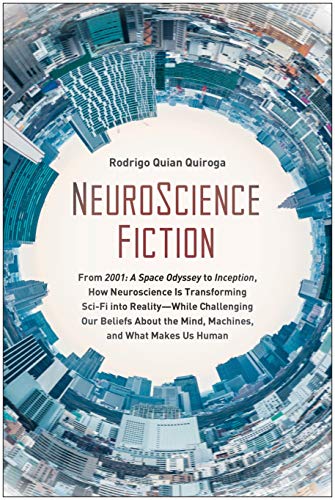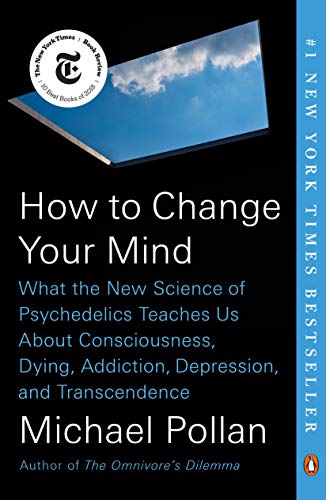One of the reasons I’m drawn to science fiction is to see how writers explore boundaries of mind and consciousness. I mean not just the sort of psychic powers that were popular to write about 40 or 50 years ago (or superheroes today) but testing the limits of human consciousness.
While sff fiction uses standard tropes about far future mind enhancements, uploading of minds, manipulation of mood by neurotransmitters and internet reception built into the visual field, the real world of research features its own eye-popping advances in neuroscience, artificial intelligence and altered states of consciousness.

This post highlights recent books that push our old ideas about the boundaries of mind, the nature of awareness and the very idea of the brain as the seat of all intelligent control of life.
In NeuroScience Fiction neuroscientist Rodrigo Quian Quiroga starts off each chapter with a summary of ideas in a major science fiction movie and then talks brilliantly about where the current science and philosophical inquiry have taken us since the film appeared. First up is Kubrick and Clark’s 2001: A Space Odyssey and computer intelligence. Then come Blade Runner on the possibility of feelings in androids, Planet of the Apes on animal consciousness, The Matrix on appearance and reality, Minority Report on free will and Inception on dream construction, along with several other major films on cyborgs, memory manipulation and mind reading.
Quian Quiroga, who discovered “concept cells” in the brain, lets the ideas, often about some of the most contested and difficult theories, flow fluently and easily, especially for a lay audience. Thanks to this book, I have a much clearer idea of how the mind constructs the processes that create the feelings of being human. He also sets out the many ideas about human consciousness and how and whether machine intelligence will ever be able to achieve a similar state of self-awareness.
The idea of memory presented here contradicts the frequent characterization of memory as a kind of database, with the attendant notion that you might be able to remove or implant memories selectively. That’s pretty basic to a lot of science fiction stories.
For Quian Quiroga, the mind constructs memories, much the way it does perceptions of the world around us, relying on a few key points and filling in the blanks. Those key points are provided by concept cells for memory and filling in the details with a story we weave about what happened in the past. As he puts it, memory is a “dynamic process that is constantly evolving, because each time we consciously access a memory we are changing it.”
He then goes on to ask the most difficult questions about how we build an overall sense of self and, above all, the belief in our own continuity throughout life. Could those neuronal connections that somehow generate our identity be preserved and transferred to a machine? If so, what would be the result? The same person or someone different?
These are a few of the probing questions that the book raises, just as the best science fiction movies and books do. NeuroScience Fiction is the best introduction I have found on how science and fiction have followed along beside each other to keep the dialogue going, even if we never find definitive answers. But Quian Quiroga definitely has his own view based on solid research on concept cells.
Moreover, the process of abstraction generates internal and subjective representations. This is precisely what is coded by our concept cells: abstractions—concepts that are closely tied to our consciousness, since these neurons fire only when we are aware of seeing something. In other words, the absence of these processes in a computer is what makes it lack general intelligence and internal representations that, I boldly suggest, perhaps are the cornerstone of our thoughts and our consciousness.
NeuroScience Fiction, Kindle edition, Location 731
He uses the movies as springboards for discussion and so only touches on a few leading ideas found in each one. I would have liked to see more about each film, but then the films can’t really answer the long-standing problems they raise about the mind. NeuroScience Fiction is an exciting way to get introduced to a host of great thinkers and learn where science has taken us thus far in deciphering the human consciousness.

How to Change Your Mind is a very different sort of book that goes directly for questions about the boundaries of mind through use of psychedelics. Written by journalist Michael Pollan, well known for his books about the food we eat, it reviews the revival of research on psychedelics in the last twenty years and what these drugs can tell us about altered states of consciousness. Like many writers who want to approach a technical subject in a non-technical way, Pollan explains the background on psychedelics through profiles of the chemists and psychologists and other researchers who have redefined this field.
That’s not my favorite approach, but the chapters are full of human interest stories about people like Albert Hoffman, the Swiss chemist who discovered the psychoactive properties of the LSD molecule in 1943 and Roland Griffiths, a researcher who produced a transformative scientific paper in 2006 on the mystical experiences induced by psylocybin.
Pollan tells the story of research, and the personal experiences of scientists and subjects alike, quite well, but he leads to a climactic section on his own experience with three different substances. In each of these, he gives his vivid account of how effectively he was able to reach a state in which the self dissolved into a larger reality. That opening of the mind to a union with all things is a hallmark of the mystical experience. While he believes what he experienced matches the criteria described by mystics and scientists alike, he remains a skeptic.
My own interpretation of what I experienced—my now officially verified mystical experience—remains a work in progress, still in search of the right words. But I have no problem using the word “spiritual” to describe elements of what I saw and felt, as long as it is not taken in a supernatural sense. For me, “spiritual” is a good name for some of the powerful mental phenomena that arise when the voice of the ego is muted or silenced.
How to Change Your Mind, Kindle edition, Location 4046
Then Pollan turns to the latest research that tries to find the neuroscientific basis for the sense of self and the specific brain chemistry of its dissolution. He dwells especially on what is known as the default neural network that reinforces the sense of a continuing self but that also defends the boundaries of the ego from letting in too much information. Psychedelics weaken those boundaries and can lead to the sensation of the mind blending into everything around it.
All in all, this makes for a pretty compelling story, even if approaching the main points through sketches of the sometimes strange characters who are contributing to contemporary knowledge takes him on a number of digressions. That’s all worthwhile.
These two books provide a fascinating background to science fictional treatments of consciousness and how it is defined and thought about by contemporary researchers. They offer the necessary insights that science is testing right now and give us the concepts for approaching fiction both as readers and writers.




Leave a Reply